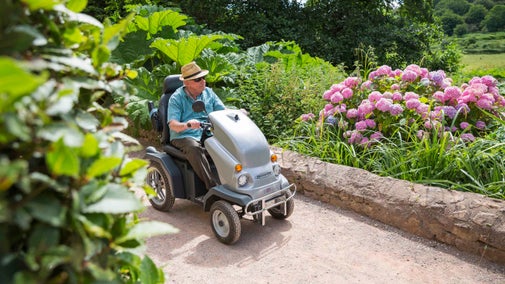
Discover more at Dunster Castle and Watermill
Find out when Dunster Castle and Watermill is open, how to get here, the things to see and do and more.

The garden at Dunster Castle and Watermill is home to exotic plants from all around the world, such as the handkerchief tree from central China and the gunnera from Brazil, planted in the early 1900s. Earlier archaeological investigation has even revealed other gardens hidden beneath the surface of what we see today. Find out how the garden has developed and grown over the centuries.
Records from 1543 refer to a walled kitchen garden east of Dunster church, but there is nothing left of this today. However, the remains of landscape designs from each of the last four centuries as well as 21st century features, can still be seen.
Very little is known about the appearance of any garden at Dunster Castle in the Middle Ages. George Luttrell commissioned William Arnold to create a Jacobean mansion in the castle buildings. However, we don’t know where or what the gardens would have looked like at that time.
Nathaniel Buck’s coloured engraving North East View of Dunster Castle of 1733 shows the New Way and the slopes just below the castle formally planted with rows of shrubs, possibly topiary. The old yew trees survived and remain today.

The motte, or mound where the castle keep had stood, once had formal planting and a flattened top. Today this area is the Keep Garden, surrounded by a wall enclosing a bowling green and summerhouse created by Dorothy Luttrell in 1721.
To offer shelter and a dining area for the participants and the ladies present during matches, the Octagon Tower was constructed. This now houses an exhibition exploring the garden's history.
George Wood’s 1735 painting shows a large walled formal garden below the castle in the park near the river, with a straight central walk, a pavilion and an open loggia. It was altered at some point and a plan from around 1750 shows a central round pool. Archaeological investigation has found many traces of this earlier garden.
Henry Fownes Luttrell instigated major changes to the castle’s parkland and garden. In 1755 he created a new, larger deer park at the castle, replacing two older, smaller ones near Blue Anchor Bay.
Accommodating the new deer park, just south of the castle, involved evicting several tenant farmers. Their leases were cancelled, hedges removed and a strong wooden fence was built to contain the deer. When the deer were moved to their new home, villagers from Dunster, Carhampton and Withycombe lined the route from the old deer parks so none could escape.
In 1775 Henry commissioned Richard Phelps to develop a picturesque-style garden. Lawns’ and Lovers’ Bridges and the rocky cascade on the River Avill were the result, along with the folly, Conygar Tower.
With far-reaching views across the Bristol Channel and Deer Park, the present-day layout of the South Terrace stems from the Victorian period. In the 1820s, at the request of George Luttrell, the architect Salvin demolished the existing Thornhill Chapel which had been built on the south facade in 1721. A new wing was constructed in its place and the resulting South Terrace was formed.

Legend has it that the seeds of the handkerchief tree, a plant rarely seen in the UK, were brought here by a former lady of the castle, Alys Luttrell, in her handbag from South Africa.
The plant, which originates from Central China, was planted by keen gardener Alys in the mid 1900s and can still be seen growing next to the Watermill. When fluttering in the breeze, the flowers look like a collection of hankies or white birds ruffling their feathers. The tree is also sometimes known as the Dove Tree or Davidia involucrate.
Native to central China, this species was discovered by Europeans in 1868 by French missionary and naturalist Père Armand David, after whom it was named. However, the plant's introduction to western gardens in 1904 was down to nursery owner Sir Harry Veitch and his plant collector, Kew-trained Ernest Wilson.
Alys Luttrell loved flowers, took pride in the garden and was an avid plant collector, so when she knew that she was heading for the British Isles, she insisted on bringing some plants with her. Alys also collected many plants that came from numerous different holiday trips. These can be seen in the river gardens and throughout the property.
Today the garden areas are known for their diversity of plants and features, with subtropical, Mediterranean and temperate plants beside the river, in herbaceous borders and the terraces. The castle grounds are also famous for their spectacular views over the Somerset countryside and the waters of the Bristol Channel.
The Lawns, 20th-century polo grounds, lie below the garden, surrounded by the Dunster estate. Its farmland, woods, forests and quarries are all now managed by the Crown Estates.

Find out when Dunster Castle and Watermill is open, how to get here, the things to see and do and more.
Explore the highlights of the garden at Dunster Castle, which takes you around the world and through four different microclimates

Dunster Castle is a two pawprint rated place. From wide open parkland to formal gardens, your dog walk needn’t be boring during your visit to Dunster Castle and Watermill.

Explore the history of the working watermill at Dunster and follow the historical milling process. Buy our organic wholemeal flour, available at the watermill and the stables shop.

There are several places to enjoy a bite to eat and a drink during your visit to Dunster Castle and Watermill. Find out more about what each outlet has to offer.

Learn about people from the past, discover remarkable works of art and brush up on your knowledge of architecture and gardens.

Explore the objects and works of art we care for at Dunster Castle on the National Trust Collections website.
